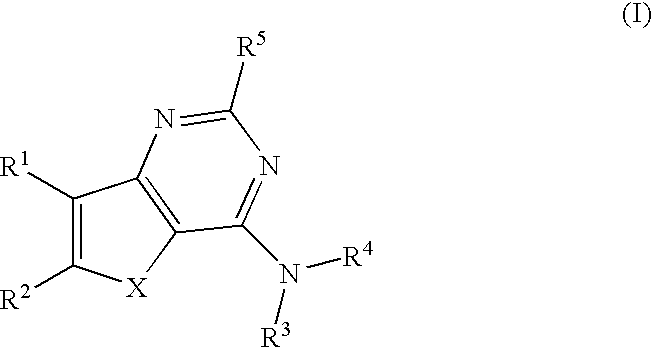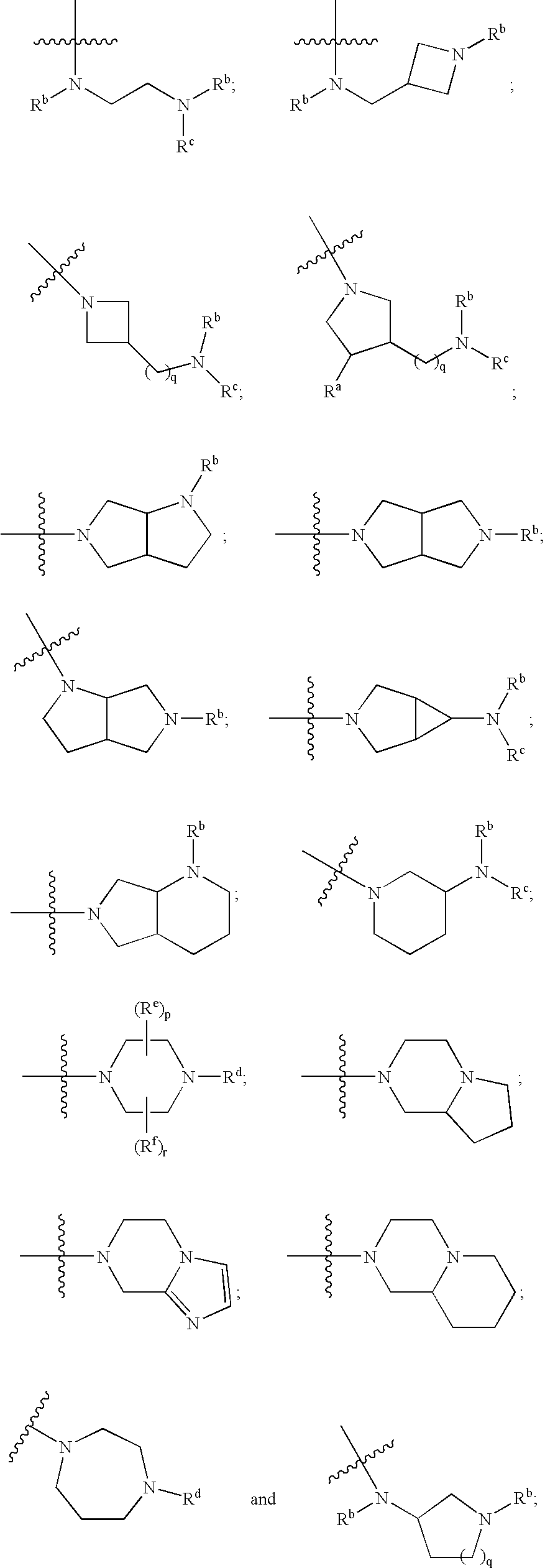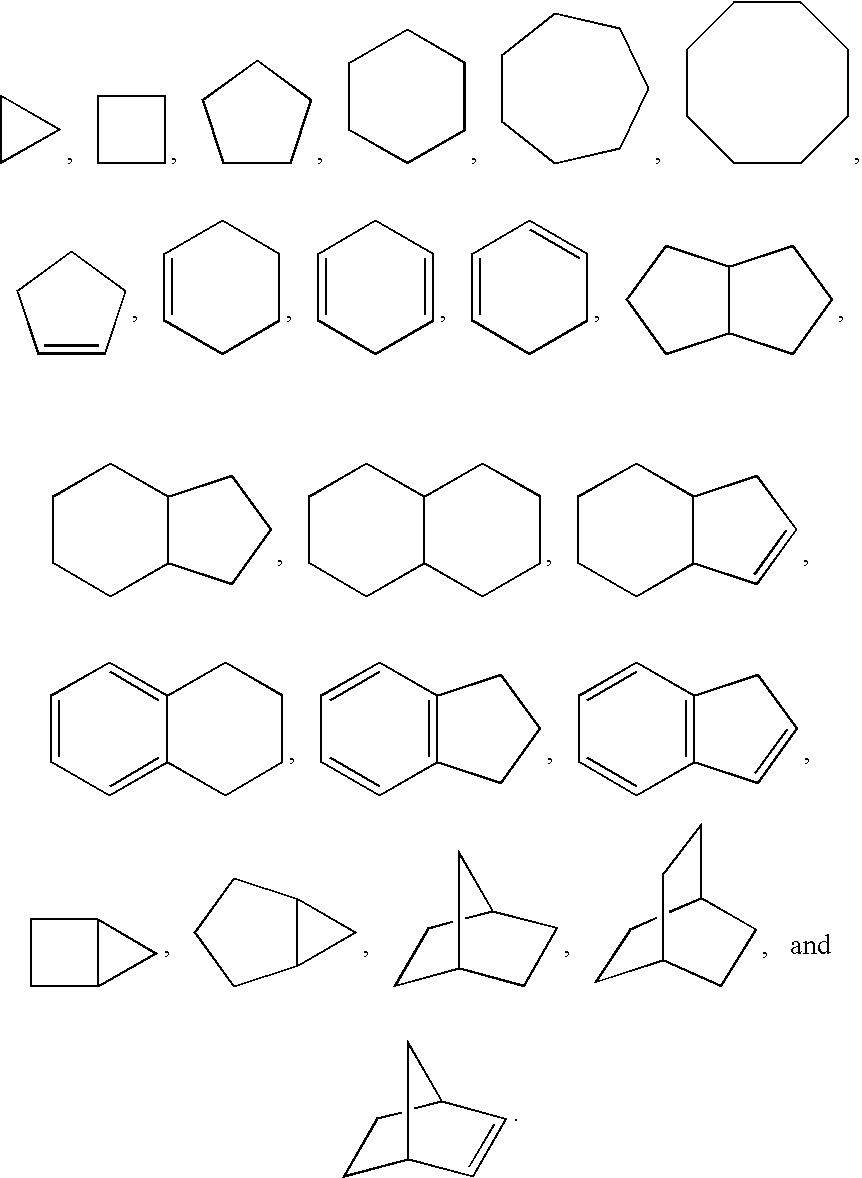Thieno- and furo-pyrimidine modulators of the histamine H4 receptor
a technology of thienopyrimidine and furopyrimidine, which is applied in the field of thienopyrimidine compounds, can solve the problems that the>1 /sub>receptor antagonists are not completely effective in the clini
- Summary
- Abstract
- Description
- Claims
- Application Information
AI Technical Summary
Benefits of technology
Problems solved by technology
Method used
Image
Examples
example 1
4-(4-Methyl-piperazin-1-yl)-thieno[3,2-d]pyrimidin-2-ylamine
[0128]
Step A: 3-Ethoxycarbonylamino-thiophene-2-carboxylic acid methyl ester
[0129]To a solution of 3-amino-thiophene-2-carboxylic acid methyl ester (2.39 g, 15.2 mmol) in benzene (51 mL) was added K2CO3 (6.30 g, 45.6 mmol) followed by ethyl chloroformate (1.74 mL, 18.2 mmol). After heating at reflux for 12 h, the mixture was filtered and the filtrate was concentrated to afford the desired product (3.43 g), which was used in the next step without further purification. MS: 230.0. 1H NMR (400 MHz, CD3OD) δ ppm 7.82 (d, J=5.5 Hz, 1H), 7.66 (d, J=5.6 Hz, 1H), 4.23 (q, J=7.1 Hz, 2H), 3.86 (s, 3H), 1.32 (t, J=7.1 Hz, 3H).
Step B: 3-Amino-1H-thieno[3,2-d]pyrimidine-2,4-dione
[0130]To a solution of 3-ethoxycarbonylamino-thiophene-2-carboxylic acid methyl ester (3.43 g, 15.0 mmol) in EtOH (100 mL) was added hydrazine monohydrate (7.98 mL, 164.6 mmol). After heating at 90° C. for 12 h, the mixture was filtered to afford a fine yellow po...
example 2
4-(4-Methyl-piperazin-1-yl)-6,7,8,9-tetrahydro-benzo[4,5]thieno[3,2-d]pyrimidin-2-ylamine
[0135]
Step A: 2-Chloro-cyclohex-1-enecarbonitrile
[0136]To a stirring solution of POCl3 (15.20 mL, 163 mmol) at 0° C. was added DMF (13.40 mL, 173 mmol) drop-wise. Monitoring internal temperature, cyclohexanone (10.60 mL, 102 mmol) was slowly added, keeping the temperature between 35 and 40° C. Upon complete addition, the reaction was heated to 50° C. and hydroxylamine hydrochloride (40 g, 576 mmol) was added in eight portions, cooling when necessary to control the exothermic reaction. Upon completing this addition, ice was added to the reaction, followed by water (400 mL), and the mixture resumed stirring for 1 h. Filtration afforded the desired product as a brown solid (8.8 g). Some substrates may require an aqueous work-up / extraction procedure if water solubility is too high. EtOAc is generally a good solvent for this extraction. MS: No signal. 1H NMR (400 MHz, CDCl3 δ ppm 2.47-2.36 (m, 2H), 2...
example 3
4-Piperazin-1-yl-6,7,8,9-tetrahydro-benzo[4,5]thieno[3,2-d]pyrimidin-2-ylamine
[0141]
[0142]To a solution of 4-(2-amino-6,7,8,9-tetrahydro-benzo[4,5]thieno[3,2-d]pyrimidin-4-yl)-piperazine-1-carboxylic acid (synthesized by the route described in Example 2, Steps A-D; 0.093 g, 0.5 mmol) in formic acid (3 mL) was added 6 N aq. HCl (0.5 mL, 3.0 mmol). After stirring at rt for 1 h, the reaction mixture was concentrated and purified by reverse-phase chromatography (acidic conditions) to afford the desired product as a TFA salt (0.009 g). MS: 290.1. 1H NMR (400 MHz, CD3OD) δ ppm 3.92-3.81 (m, 4H), 2.92-2.87 (m, 4H), 2.82-2.75 (m, 2H), 2.62 (t, J=6.0 Hz, 2H), 1.96-1.80 (m, 4H).
PUM
| Property | Measurement | Unit |
|---|---|---|
| weight | aaaaa | aaaaa |
| flow rate | aaaaa | aaaaa |
| flow rate | aaaaa | aaaaa |
Abstract
Description
Claims
Application Information
 Login to View More
Login to View More - R&D
- Intellectual Property
- Life Sciences
- Materials
- Tech Scout
- Unparalleled Data Quality
- Higher Quality Content
- 60% Fewer Hallucinations
Browse by: Latest US Patents, China's latest patents, Technical Efficacy Thesaurus, Application Domain, Technology Topic, Popular Technical Reports.
© 2025 PatSnap. All rights reserved.Legal|Privacy policy|Modern Slavery Act Transparency Statement|Sitemap|About US| Contact US: help@patsnap.com



